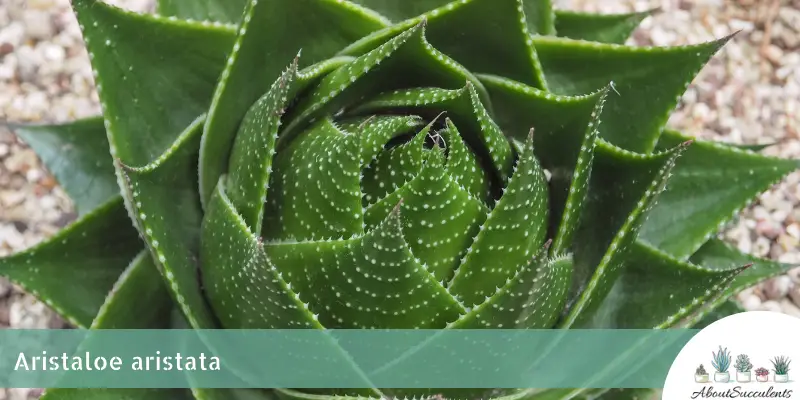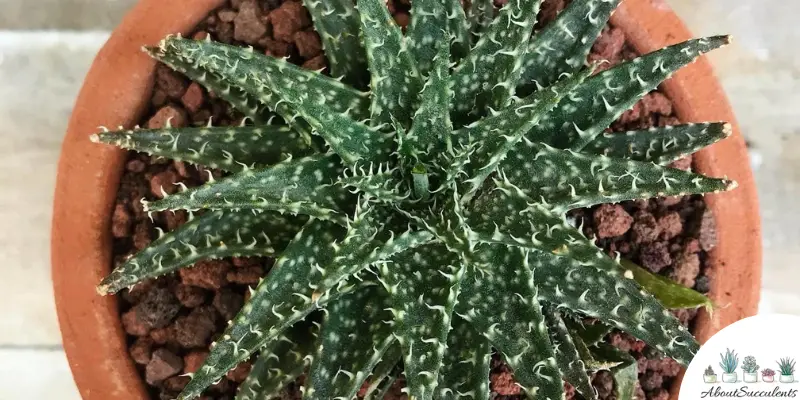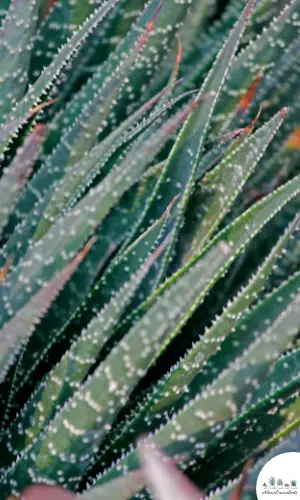
Aristaloe Aristata, also known as Lace Aloe, Guinea Fowl Aloe, or Torch Plant is a fast-growing stemless succulent that’s become popular because of its beguiling appearance.
Lace Aloe form tightly knit rosettes of long, fleshy, dark green leaves mottled with white bumps and tipped with thread-like spines.
The edges of its lanceolate leaves are laced with white teeth. Guinea Fowl Aloe can pass for plant life from another planet.
Aristaloe Aristata can grow up to 20cm – 30.5cm (8”-12”) tall and 15cm (6”) wide.
In early summer, the Torch Plant blooms orange tubular flowers that grow on stalks that can shoot up to 50cm(20”) tall. The flowers grow up to 4cm (1.6”) long.
Aristaloe Aristata is native to the grasslands of Lesotho and South Africa. It is the only species of the Aristaloe genus from the Asphodelaceae family.
General Information
Also known as: Lace Aloe, Guinea Fowl Aloe, Torch Plant
Plant Family: Asphodelaceae
Origin: Lesotho and South Africa
Height: 20cm to 30.5cm (8”to 12”)
Exposure: Full to Partial Sun
Water needs: Drought-tolerant; use the ‘soak and dry’ watering method
Soil Type: Cactus or succulent potting soil mixed with gritty materials such as perlite, coarse sand, or fine gravel.
Soil pH: 6.6 to 7.5
How to Grow Aristaloe Aristata

Aristaloe Aristata is an easy-to-care-for houseplant. This is a type of succulent that’s perfect for newbie growers because Lace Aloe does not need too much attention.
The Torch Plant is a perfect addition to an indoor mini succulent garden or an outdoor rock garden.
The Lace Aloe is semi-hardy and it can tolerate temperatures as low as -12.2°C – 4°C (10°F – 39°F). It grows best at temperatures above 10°C (50°F).
Sunlight
Aristaloe Aristataloves the sun and would grow well outdoors in a location exposed to bright light for 4 to 6 hours a day. Keep it away from intense light or provide light shade to prevent sunburn.
If you will grow lace Aloe indoors, place the container in the west or south-facing window. Rotate your pot once or twice a week to ensure that all sides get exposed to sunlight.
Make sure that Guinea Fowl Aloe will get adequate light to prevent etiolation, a condition where the leaves stretch out to find sunlight. Get a grow light if you do not have a place in your house that gets sufficient bright light.
Watering

Aristaloe Aristata is drought tolerant because it stores enough water in its fleshy leaves. Feeding it with too much water is bad for its health. When your Lace Aloe sits in damp soil for too long, it will be prone to root rot.
It is best to use the ‘soak and dry’ watering method. Before you water, insert your finger 2” deep into the soil to check if it is no longer moist. Remember to water the soil only and avoid watering from the top to prevent leaf rot.
During summer, water your Torch Plant once every 7 to 14 days because the soil dries out faster. During winter, the soil retains moisture longer so increase your watering intervals.
Pot and Soil
The best pots for Aristaloe Aristata are made of terracotta or ceramic. They are made with breathable materials that will enable proper air circulation and fast moisture evaporation.
Get pots with drainage holes to prevent water retention that is harmful to succulents.
Succulents thrive best in cactus or succulent potting soil mixed with gritty materials such as perlite, coarse sand, or fine gravel to allow better drainage and soil aeration.
During spring, feed Guinea Fowl Aloe with liquid fertilizer once a month to boost its growth. Taper off the feeding during its dormant phase. Once Torch Plant reaches maturity, you can fertilize it once a year.
How to Propagate Aristaloe Aristata
Aristaloe Aristata can be propagated by using offsets and leaf cuttings from a mature plant. The best time to propagate is during the growing season of Aloes which is in spring and summer.
Method 1 – Offsets
Step 1: Check the base of the plant for offsets. Choose the ones that have formed mini rosettes of leaves.
Step 2: Moisten the soil and gently remove the mother plant along with offsets. Brush away the soil. Carefully untangle the offsets from the mother plant. You can use a sterile sharp knife or scissors to separate them.
Step 3: Replant the mother plant in its pot. Plant the offsets ¾ in deep in terracotta or ceramic pots filled with the same potting mix used for the mother plant.
Step 4: Place the containers in an area that gets indirect bright light. Wait three days to water the soil to give the roots time to heal from the separation.
Method 2 – Leaf Cuttings
Step 1: Cut healthy leaves with a sharp sterile knife or razor blade from the mother plant. Make sure the cut is clean and smooth, not jagged.
Step 2: Place the leaf cuttings in a dry and warm area for a few days to allow the cut wounds to seal.
Step 3: Stick the cuttings in terracotta pots filled with cactus or succulent potting soil mixed with gritty materials. Make sure the pots have drainage holes.
Step 4: Mist the soil regularly. Once the cuttings grow roots and new leaves, use the ‘soak and dry’ watering method.
Frequently Asked Questions
Is Aristaloe Aristata Toxic to Cats and Dogs?
Aristaloe Aristata is not included in the list of plants that are toxic to Cats and Dogs on the website of the American Society for the Prevention of Cruelty to Animals (ASPCA).
Why is my Aristaloe Aristata Dying?
Is your Lace Aloe looking unwell? Your succulent’s deteriorating health can be caused by overwatering the soil or having it infested by freeloading pests.
Overwatering
Aristaloe Aristata can easily bounce back from underwatering but it cannot tolerate excessive watering. If not treated early, your plant can die from root rot.
Remove your Lace Aloe from the pot and gently remove the soil from the roots. Cut out the damaged roots with a sterile sharp knife or razor.
Leave the plant in a dry, warm, and shaded area. Get a terracotta or ceramic pot with drainage holes. Fill it with 50% cactus or succulent potting mix and 50% perlite, pebbles, and gravel.
Repot your Guinea Fowl Aloe and place it in a partially shaded area. Water it after three days.
Pest Infestation
Aristaloe Aristata attracts mealybugs and scales. To remove these sap-sucking pests, use a pressure water sprayer to wash your plant.
You can also spray the upper and lower parts of the leaves with 70% isopropyl alcohol or wipe the leaves with diluted neem oil.
Does Aristaloe Aristata Produce Flowers?
Yes. During summer, Aristaloe Aristata blooms orange tubular flowers that grow up to 4cm (1.6”) long.
Last Updated on June 9, 2022 by Sofia Lara